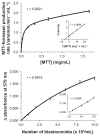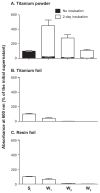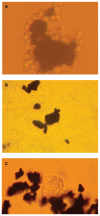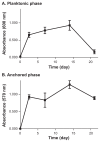Candida albicans biofilm on titanium: effect of peroxidase precoating
- PMID: 22915919
- PMCID: PMC3417863
- DOI: 10.2147/mder.s11724
Candida albicans biofilm on titanium: effect of peroxidase precoating
Abstract
The present study aimed to document Candida albicans biofilm development on titanium and its modulation by a peroxidase-precoated material which can generate antimicrobials, such as hypoiodite or hypothiocyanite, from hydrogen peroxide, iodide, or thiocyanate. For this purpose, titanium (powder or foil) was suspended in Sabouraud liquid medium inoculated with C. albicans ATCC10231. After continuous stirring for 2-21 days at room temperature, the supernatant was monitored by turbidimetry at 600 nm and titanium washed three times in sterile Sabouraud broth. Using the tetrazolium salt MTT-formazan assay, the titanium-adherent fungal biomass was measured as 7.50 ± 0.60 × 10(6) blastoconidia per gram of titanium powder (n = 30) and 0.50 ± 0.04 × 10(6) blastoconidia per cm(2) of titanium foil (n = 12). The presence of yeast on the surface of titanium was confirmed by microscopy both on fresh preparations and after calcofluor white staining. However, in the presence of peroxidase systems (lactoperoxidase with substrates such as hydrogen peroxide donor, iodide, or thiocyanate), Candida growth in both planktonic and attached phases appeared to be inhibited. Moreover, this study demonstrates the possible partition of peroxidase systems between titanium material (peroxidase-precoated) and liquid environment (containing peroxidase substrates) to limit C. albicans biofilm formation.
Keywords: adhesion; material; oral; yeast.
Figures





Similar articles
-
Candida albicans susceptibility to lactoperoxidase-generated hypoiodite.Clin Cosmet Investig Dent. 2010 Aug 4;2:69-78. doi: 10.2147/cciden.s10891. Print 2010. Clin Cosmet Investig Dent. 2010. PMID: 23662084 Free PMC article.
-
The Discrepancy between Clove and Non-Clove Cigarette Smoke-Promoted Candida albicans Biofilm Formation with Precoating RNA-aptamer.F1000Res. 2021 May 11;10:372. doi: 10.12688/f1000research.52266.3. eCollection 2021. F1000Res. 2021. PMID: 34367616 Free PMC article.
-
Ex vivo decontamination of yeast-colonized dentures by iodine-thiocyanate complexes.Clin Cosmet Investig Dent. 2018 Jul 25;10:149-158. doi: 10.2147/CCIDE.S165377. eCollection 2018. Clin Cosmet Investig Dent. 2018. PMID: 30100762 Free PMC article.
-
Effects of the binding of a Helianthus annuus lectin to Candida albicans cell wall on biofilm development and adhesion to host cells.Phytomedicine. 2019 May;58:152875. doi: 10.1016/j.phymed.2019.152875. Epub 2019 Feb 27. Phytomedicine. 2019. PMID: 30884454
-
Susceptibility of Candida albicans to peroxidase-catalyzed oxidation products of thiocyanate, iodide and bromide.J Biol Buccale. 1992 Dec;20(4):241-5. J Biol Buccale. 1992. PMID: 1306188
Cited by
-
Structural and biological evaluation of lignin addition to simple and silver-doped hydroxyapatite thin films synthesized by matrix-assisted pulsed laser evaporation.J Mater Sci Mater Med. 2015 Jan;26(1):5333. doi: 10.1007/s10856-014-5333-y. Epub 2015 Jan 13. J Mater Sci Mater Med. 2015. PMID: 25578691
-
Effects of magnolol and honokiol on adhesion, yeast-hyphal transition, and formation of biofilm by Candida albicans.PLoS One. 2015 Feb 24;10(2):e0117695. doi: 10.1371/journal.pone.0117695. eCollection 2015. PLoS One. 2015. PMID: 25710475 Free PMC article.
-
Candida albicans aspects of binary titanium alloys for biomedical applications.Regen Biomater. 2020 Mar;7(2):213-220. doi: 10.1093/rb/rbz052. Epub 2020 Jan 25. Regen Biomater. 2020. PMID: 32296540 Free PMC article.
-
A paradigm for the evaluation and management of spinal coccidioidomycosis.Surg Neurol Int. 2015 Jun 17;6:107. doi: 10.4103/2152-7806.158979. eCollection 2015. Surg Neurol Int. 2015. PMID: 26167359 Free PMC article. Review.
References
-
- Brouns F, Schuermans A, Verhaegen J, De Wever I, Stas M. Infection assessment of totally implanted long-term venous access devices. J Vasc Access. 2006;7:24–28. - PubMed
-
- Chang L, Tsai JS, Huang SJ, Shih CC. Evaluation of infectious complications of the implantable venous access system in a general oncologic population. Am J Infect Control. 2003;31:34–39. - PubMed
-
- Opilla M. Epidemiology of bloodstream infection associated with parenteral nutrition. Am J Infect Control. 2008;36:S173.e5–e8. - PubMed
-
- Holzheimer RG, Dralle H. Management of mycoses in surgical patients – review of the literature. Eur J Med Res. 2002;7:200–206. - PubMed
LinkOut - more resources
Full Text Sources

